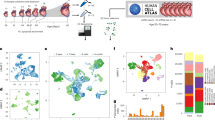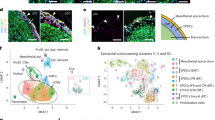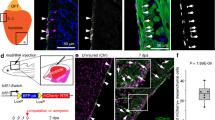Abstract
Replying to: V. M. Christoffels et al. Nature 458, 10.1038/nature07916 (2009)
We recognized the importance of confirming data from Cre lineage studies with an alternative approach, and thus used a fluorescent dye to lineage-label epicardial cells. This approach confirmed that epicardial cells contributed to myocytes within the heart1. In our experiments, we never observed Tbx18 mRNA within ventricles at embryonic day E10.5 to E11.5, although our RNA signal in epicardium at these stages is at least as strong as that observed by Christoffels et al.2. We note a discrepancy between amount of RNA staining (broadly throughout the middle of the ventricle) and protein staining (much more restricted) that Christoffels et al.2 observe at early stages. Reasons for discrepancies between our RNA in situ data and that of Christoffels et al. are unclear. Christoffels et al.2 detect Tbx18 intronic sequences by RT–PCR of E11.5 IVS, but do not provide data to demonstrate mature Tbx18 mRNA. Notably, we did observe active expression of Tbx18 in non-myocytes after E11.5 (ref. 1).
This is a preview of subscription content, access via your institution
Access options
Subscribe to this journal
Receive 51 print issues and online access
$199.00 per year
only $3.90 per issue
Buy this article
- Purchase on Springer Link
- Instant access to full article PDF
Prices may be subject to local taxes which are calculated during checkout
Similar content being viewed by others
References
Cai, C. L. et al. A myocardial lineage derives from Tbx18 epicardial cells. Nature 454, 104–108 (2008)
Christoffels, V. M. et al. Tbx18 and the fate of epicardial progenitors. Nature 458 10.1038/nature07916 (2009)
Soloff, R. S., Katayama, C., Lin, M. Y., Feramisco, J. R. & Hedrick, S. M. Targeted deletion of protein kinase C lambda reveals a distribution of functions between the two atypical protein kinase C isoforms. J. Immunol. 173, 3250–3260 (2004)
Herzer, U., Crocoll, A., Barton, D., Howells, N. & Englert, C. The Wilms tumor suppressor gene Wt1 is required for development of the spleen. Curr. Biol. 9, 837–840 (1999)
Kreidberg, J. A. et al. WT-1 is required for early kidney development. Cell 74, 679–691 (1993)
Moore, A. W., McInnes, L., Kreidberg, J., Hastie, N. D. & Schedl, A. YAC complementation shows a requirement for Wt1 in the development of epicardium, adrenal gland and throughout nephrogenesis. Development 126, 1845–1857 (1999)
Zhou, B. et al. Epicardial progenitors contribute to the cardiomyocyte lineage in the developing heart. Nature 454, 109–113 (2008)
Author information
Authors and Affiliations
Rights and permissions
About this article
Cite this article
Cai, CL., Martin, J., Sun, Y. et al. Cai et al. reply. Nature 458, E9–E10 (2009). https://doi.org/10.1038/nature07917
Issue Date:
DOI: https://doi.org/10.1038/nature07917
Comments
By submitting a comment you agree to abide by our Terms and Community Guidelines. If you find something abusive or that does not comply with our terms or guidelines please flag it as inappropriate.



